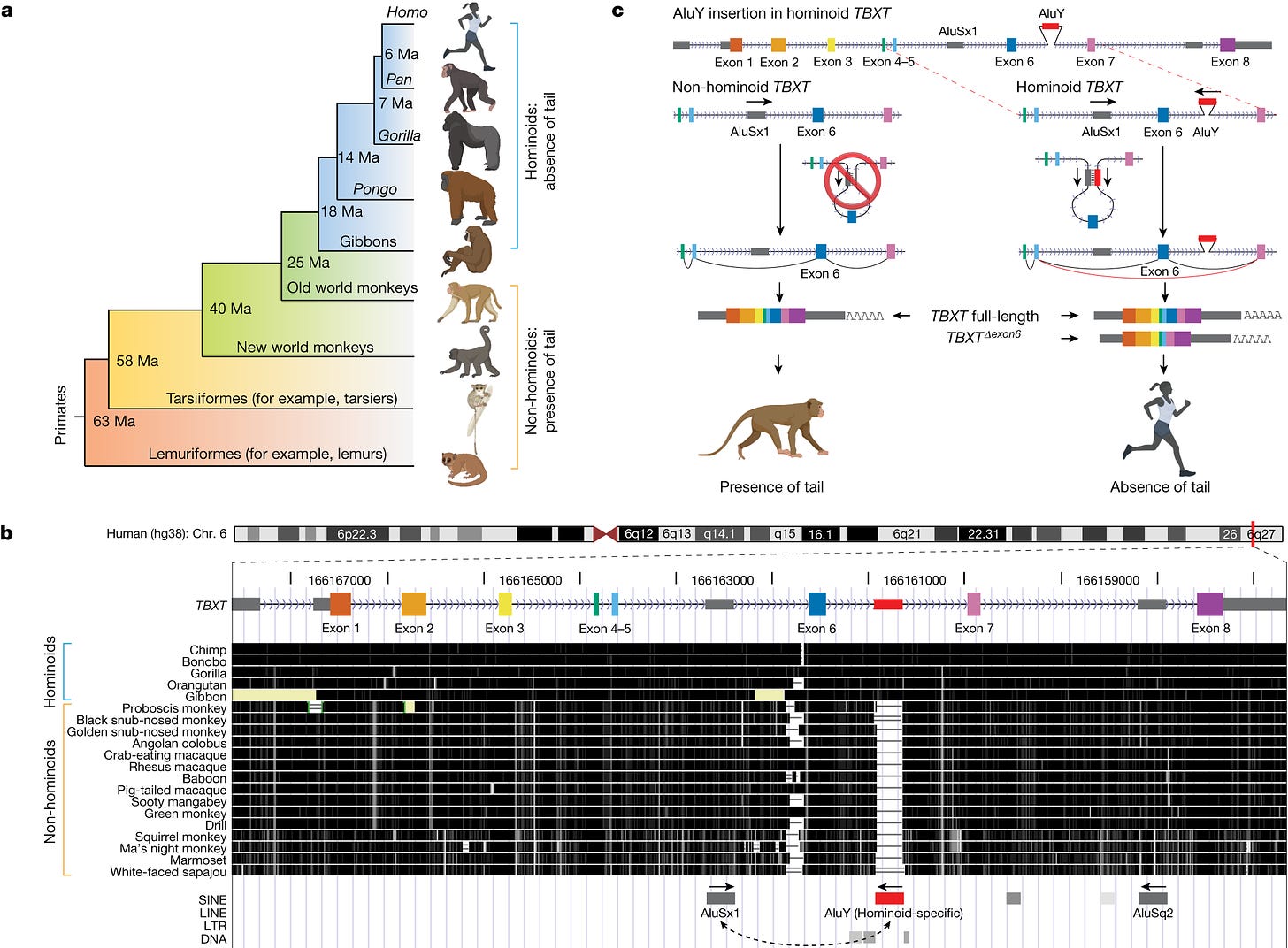Subscribe to Genomely for the latest discoveries and in-depth analyses in your inbox.
Thank you to our subscribers for your continued support and passion for science!
The tail, a distinctive feature across vertebrate species, serves diverse functions, from balance and locomotion to grasping and signaling. Interestingly, this feature undergoes significant modifications among primates, adapting to various environments and affecting their mobility styles. A fascinating instance is the prehensile tail of New World howler monkeys, evolved for better grasping in arboreal habitats. In stark contrast, hominoids, including humans and apes, present an intriguing case: they have completely lost their external tail. This evolutionary change, estimated to have occurred around 25 million years ago, has left humans with merely 3–5 caudal vertebrae forming the coccyx or tailbone.
The Evolutionary Trail of Tail Loss
The phenomenon of tail loss in hominoids is closely linked to the shift towards bipedal locomotion. This change not only altered the physical landscape of early hominoids but also posed questions about the genetic mechanisms facilitating such evolutionary shifts. The puzzle remains, as the exact genetic pathways that led to the loss of the tail and the adoption of bipedalism remain largely unexplored.
Recent advancements in primate genome sequencing have opened new avenues to explore these genetic mysteries. By comparing the genomes across different primate species, scientists aim to uncover the genetic variants responsible for these phenotypic changes. In this regard, the TBXT gene has come under significant scrutiny. TBXT, a gene integral to tail development, shows variations that might explain the tail loss in hominoids. Particularly, an AluY element insertion within this gene seems to have played a critical role.
An Insertion Event and a Tail Disappearance
Alu elements, a type of transposable element, are abundant in primate genomes. The insertion of an AluY element, specific to hominoids, into the TBXT gene appears to coincide with the timeframe when our ancestors lost their tails. This insertion, situated away from the nearest coding exon, is unusual and does not directly affect splicing. However, it forms a unique pair with another Alu element, possibly influencing the gene's expression and contributing to the evolutionary tail loss.
Experimental Insights from Mouse Models
To understand the implications of these genetic variations, scientists have turned to mouse models. By editing mouse genomes to replicate the human TBXT structure, researchers observed changes in tail development, providing a window into the potential genetic underpinnings of tail loss in hominoids. These experiments underscore the power of genetic mutations, particularly in non-coding regions, to drive significant evolutionary changes.
The Evolutionary Trade-offs and Questions Unanswered
The loss of the tail in hominoids likely offered significant advantages, perhaps related to locomotion and habitat adaptation. However, this evolutionary leap might not have been without its trade-offs, such as potential susceptibility to neural tube defects, a hypothesis supported by observations in modified mouse models. This trade-off underscores the complex interplay between genetic changes and their phenotypic consequences.
Furthermore, while we have identified potential genetic contributors to tail loss, many questions remain. How do these genetic changes translate into the physical loss of the tail? What other genetic modifications accompanied this significant morphological change? And how did these changes influence other aspects of hominoid evolution?
Looking Forward: Implications and Explorations
The journey to uncover the genetic story behind tail loss in hominoids is far from over. This line of research not only helps us understand our evolutionary past but also provides insights into current human biology and potential health implications. As we delve deeper into the genetic basis of our evolutionary history, we continue to uncover the intricate tapestry of life that connects us to our distant ancestors.
In conclusion, the tale of the lost tail in hominoids is a testament to the complexity and dynamism of evolution. It reminds us of the intricate dance between genetics and environment that shapes the course of life on Earth. As we continue to unravel these mysteries, we edge closer to understanding the essence of our being and our place in the natural world.





